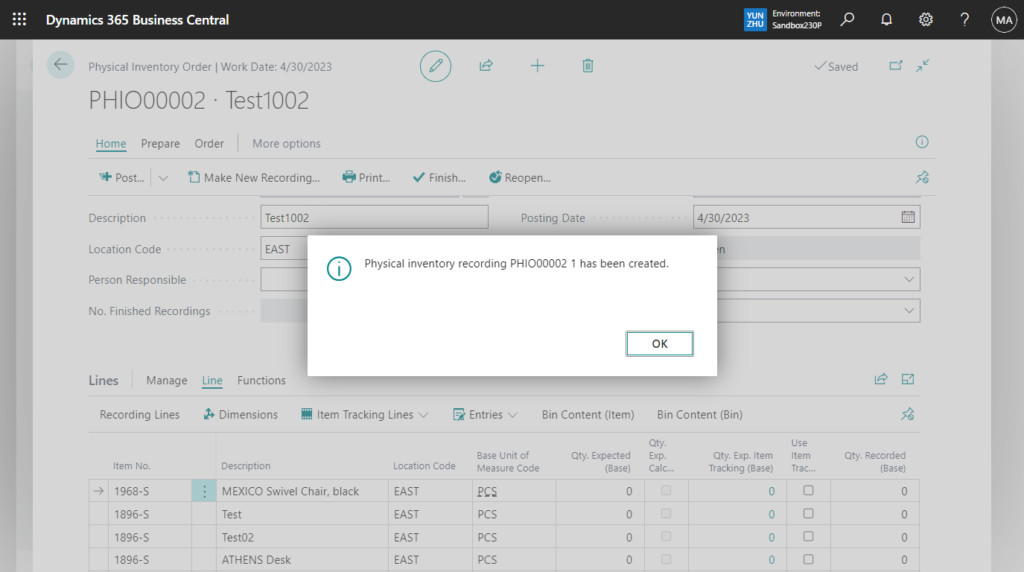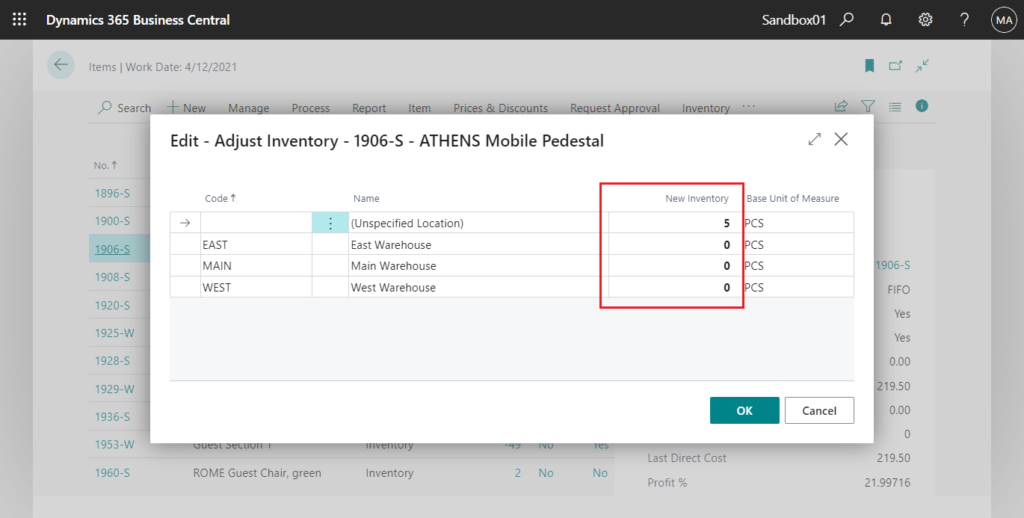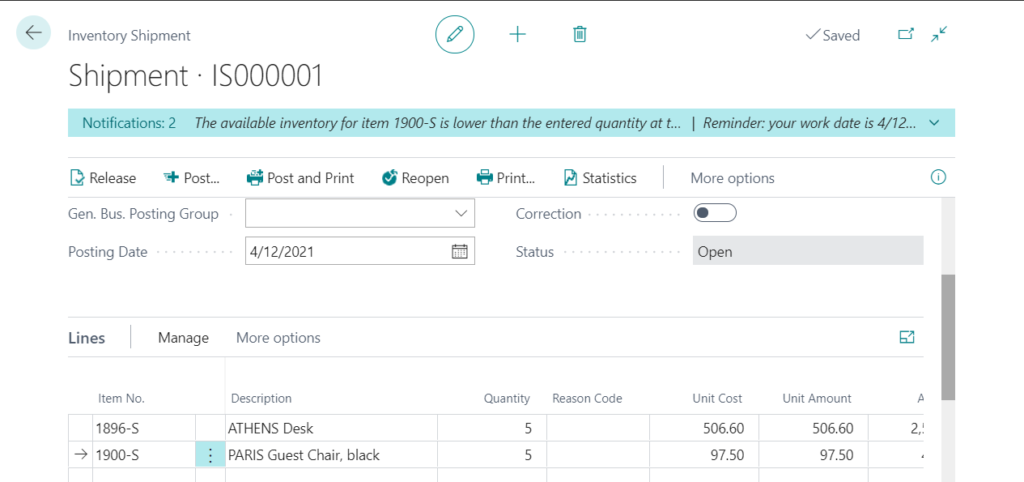Hi, Readers.
The public preview for Dynamics 365 Business Central 2023 release wave 2 (BC23) is available. Learn more: Link.
I will continue to test and share some new features that I hope will be helpful.
Improved processes for inventory counts and adjustments:
Business value:
Productivity increases when processes are easy, so we’ve improved the usability of several processes for counting and adjusting inventory. For example, you can include items in physical inventory orders regardless of their availability or turnover, and in several places data is easier to access and digest.Feature details:
Based on feedback from our customers, we’ve made it easier to complete the count and adjust inventory processes.There are changes in the Physical Inventory Order, Inventory Receipt and Inventory Shipment documents, and the Adjust Inventory page.
https://learn.microsoft.com/en-us/dynamics365/release-plan/2023wave2/smb/dynamics365-business-central/improved-processes-inventory-counts-adjustments
Include items without transactions when you calculate lines on physical inventory orders
You can use physical inventory orders and physical inventory recording documents to take a physical inventory of your items. The Physical Inventory Order page organizes the inventory counting project. For example, one project per location. The lines on physical inventory orders contain information about the items.
To create the physical inventory order lines, you typically use the Calculate Lines function to reflect the current inventory as lines on the order. Alternatively, you can use the Copy from Document function to fill the lines with the content of another open or posted physical inventory order. The following procedure only describes how to use the Calculate Lines function. For example,
Choose Tell me icon, enter Physical Inventory Orders, and then choose the related link.

Choose the New action.

Fill in the required fields on the General FastTab. Hover over a field to read a short description.

Choose the Calculate Lines action.

Select options or filters as necessary. Choose the OK button.


More details: To create a physical inventory order
In this release (BC23), Microsoft has added an Include Items without Transactions field to align the Physical Inventory Order and Physical Inventory Journal pages.
Include Items without Transactions
Specifies if physical inventory order lines should be created for items that are not on inventory and are not used in any transactions.

The following table shows the expected result of different combinations.
| Items Not on Inventory | Include Items without Transactions | Lines inserted on the order |
|---|---|---|
| Off | Off | For each item that exists at the chosen location. |
| On | Off | For each item that isn’t in inventory, but has transactions at the chosen location. |
| On | On | For each item that isn’t in inventory and doesn’t have transactions at the chosen location. |
PS: In previous versions

And on the Physical Inventory Journal page: (This was in the previous version)


Item references in physical inventory documents
For each physical inventory order, you can create one or more physical inventory recording documents on which employees enter the counted quantities, either manually or through an integrated scanning device.





More details: To create a physical inventory recording
Microsoft has added the Item Reference No. field to the Physical Inventory Recording Lines. In combination with the Allow Recording Without Order toggle, it improves ad-hoc counting, which might be useful when you use bins.


The Item Reference No. field is also added to Physical Inventory Order Lines. There, the field is useful when you define the scope for counting by importing lines from Excel using configuration packages. More details: Add more columns to pages for better insight (Description 2 field and Item Reference No. field)

Control over adjustment of one item
The Adjust Inventory dialog is helpful when you need to quickly adjust the inventory level for a specific item. More details: How to quickly adjust the inventory of one item


However, larger organizations might require a more elaborate process. In this release, you can enable the Adjust Inventory feature by turning on the Allow Invt. Adjustment toggle on the Inventory Setup page.
Allow Inventory Adjustment
Specifies if you want to allow manual adjustment of the inventory in the item card.

PS: In the current BC 23 Privew version (2023.10.02), this option only prohibits users from using Inventory Adjustment on Item Card, but it can still be used in Item List. Maybe Microsoft will fix it in future versions.

And Microsoft has added two new fields.
We’ve made the Adjust Inventory feature useful in multiuser environments. You state the actual quantity in the New Inventory field, which allows you to correct mistakes if another user works with the same item and posts a sales or purchase transaction.
Current Inventory
Specifies the quantity on hand for the item at location.
Qty. to Adjust
Specifies the quantity that will be added to or subtracted from the current inventory quantity when you choose the OK button.

PS: In previous versions

Corrections are easier when you copy inventory shipment and inventory receipts
You can use the Inventory Receipt and Inventory Shipment documents to adjust your inventory. You can print these documents at any stage, release and reopen them, and assign common values, including dimensions, in the header. More details: Dynamics 365 Business Central 2021 release wave 1 (BC18): Inventory documents – new capability to adjust your inventory (Inventory Receipts and Inventory Shipments)

You can use the Correction checkbox if you need to post a corrective entry to an inventory. If you select the checkbox, when you post a corrective entry Business Central uses a negative quantity but keeps the entry type.
Correction
Specifies the entry as a corrective entry. You can use the field if you need to post a corrective entry to an account.

For example, you post the inventory receipt with a quantity of 500, but later discover the entry isn’t correct. You can write off quantity using an inventory shipment, or you can post an inventory receipt that’s marked as a correction. In the first case, Business Central creates a negative adjustment entry type. When you use a correction the entry will be a positive adjustment, but with a negative quantity. While the total turnover will be the same, if you run an analysis by entry type, the results will be different. In the second case, the total positive adjustment will be zero.
If you use item tracking, you definitely want to use the Copy Document action to fill in the document, tracking, and application information.

In this release, the following toggles give you better control over what will be entered in the document, and how:
- Copy as Correction. Useful if you copy a posted document to a new document of the same type—for example, posted inventory receipt into inventory receipt—and you want to have an opposite sign. Note that if the posted document is already marked as a correction, the setting is ignored.
Copy as Correction
Specifies that new document will be marked as Correction.

- Copy Item Tracking value. Define whether you want to populate item tracking details, such as lot or serial number from a source document. If the Specify appl. entry toggle is enabled, Business Central will populate Apply from entry / Apply to entry fields. Note that for a successful application, the sign of the target document should be the opposite. For example, from a posted inventory receipt to an inventory shipment, or from a posted inventory receipt to a correcting inventory receipt.

It’s also easier now to delete inventory shipments or inventory receipts that contain lines with item tracking. The new behavior is similar to what we already have in purchase and sales documents, where instead of blocking users it shows a confirmation dialog.

Shipment IS000003 has item reservation. Do you want to delete it anyway?

PS: In previous versions
Item tracking is defined for item 1896-S LOT in the Item Document Line. You must delete the existing item tracking before modifying or deleting the Item Document Line.

Great improvement. Give it a try!!!😁
END
Hope this will help.
Thanks for reading.
ZHU




コメント